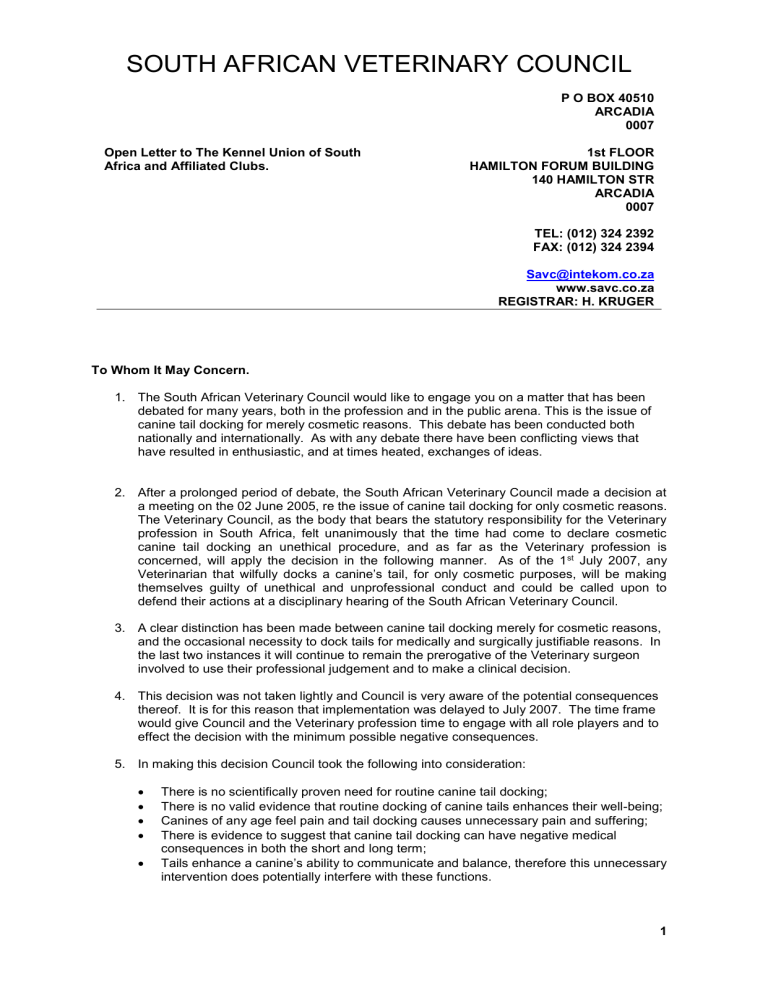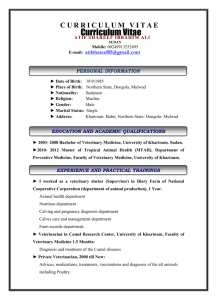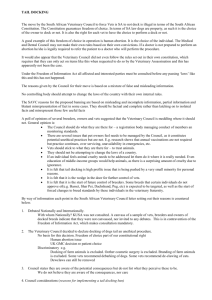SOUTH AFRICAN VETERINARY COUNCIL

SOUTH AFRICAN VETERINARY COUNCIL
Open Letter to The Kennel Union of South
Africa and Affiliated Clubs.
P O BOX 40510
ARCADIA
0007
1st FLOOR
HAMILTON FORUM BUILDING
140 HAMILTON STR
ARCADIA
0007
TEL: (012) 324 2392
FAX: (012) 324 2394
Savc@intekom.co.za
www.savc.co.za
REGISTRAR: H. KRUGER
To Whom It May Concern.
1. The South African Veterinary Council would like to engage you on a matter that has been debated for many years, both in the profession and in the public arena. This is the issue of canine tail docking for merely cosmetic reasons. This debate has been conducted both nationally and internationally. As with any debate there have been conflicting views that have resulted in enthusiastic, and at times heated, exchanges of ideas.
2. After a prolonged period of debate, the South African Veterinary Council made a decision at a meeting on the 02 June 2005, re the issue of canine tail docking for only cosmetic reasons.
The Veterinary Council, as the body that bears the statutory responsibility for the Veterinary profession in South Africa, felt unanimously that the time had come to declare cosmetic canine tail docking an unethical procedure, and as far as the Veterinary profession is concerned, will apply the decision in the following manner. As of the 1 st July 2007, any
Veterinarian that wilfully docks a canine’s tail, for only cosmetic purposes, will be making themselves guilty of unethical and unprofessional conduct and could be called upon to defend their actions at a disciplinary hearing of the South African Veterinary Council.
3. A clear distinction has been made between canine tail docking merely for cosmetic reasons, and the occasional necessity to dock tails for medically and surgically justifiable reasons. In the last two instances it will continue to remain the prerogative of the Veterinary surgeon involved to use their professional judgement and to make a clinical decision.
4. This decision was not taken lightly and Council is very aware of the potential consequences thereof. It is for this reason that implementation was delayed to July 2007. The time frame would give Council and the Veterinary profession time to engage with all role players and to effect the decision with the minimum possible negative consequences.
5. In making this decision Council took the following into consideration:
There is no scientifically proven need for routine canine tail docking;
There is no valid evidence that routine docking of canine tails enhances their well-being;
Canines of any age feel pain and tail docking causes unnecessary pain and suffering;
There is evidence to suggest that canine tail docking can have negative medical consequences in both the short and long term;
Tails enhance a canine’s ability to communicate and balance, therefore this unnecessary intervention does potentially interfere with these functions.
1
6. It is unacceptable to cause unnecessary pain and suffering in an animal simply because it enhances the perceived ideal conformation as determined by breed standards, when there is no evidence proving that the procedure has any benefit for the animal.
7. Similar procedures in other species are performed for specific and justifiable reasons. Each procedure must be evaluated on its own merits, as the tail docking in sheep, for example, differs from those of canines. While the veterinary profession is currently evaluating all veterinary procedures that may be painful and unnecessary, the issue at hand right now is that of routine canine tail docking. The issue of canine ear cropping was dealt with in a similar manner in the recent past. The profession is addressing these matters by objectively assessing the reasons for, and implications of, each procedure individually.
8. There is also an international move to do away with, as far as possible, procedures that cause pain and suffering to an animal, unless the procedure can be objectively and professionally justified.
9. In Australia the nationally applicable Animal Welfare Act specifically declares cosmetic tail docking of dogs illegal. This means that if a Veterinarian is charged by the Australia Royal
Society for Prevention of Cruelty to Animals for performing this illegal procedure on an animal, and found guilty, the regional Veterinary Board that veterinarian is registered with will have no option but to institute a disciplinary inquiry into their professional conduct. This would result in the Veterinarian concerned not only having a criminal conviction but they would probably be found guilty of unprofessional conduct with resultant censure from the
Veterinary Board.
10. In Western Australia the regional Veterinary Board itself has already declared cosmetic tail docking of dogs unprofessional and unethical.
11. In New Zealand there is before parliament an amendment to the current Animal Welfare Act that will add cosmetic canine tail docking to the list of restricted surgical procedures. This amendment will be passed into law during 2006. Currently the New Zealand Veterinary
Council strongly discourages its registered members from doing canine tail docking for merely cosmetic reasons. Once the national law is amended and a veterinarian is charged and found guilty under the national welfare legislation they will then have to face a charge of unprofessional conduct initiated by the New Zealand Veterinary Council.
12. In England the Royal College of Veterinary Surgeons, their veterinarian’s statutory body, states in their professional guidelines that canine tail docking can only be done for justifiable medical and surgical reasons.
13. The South African Veterinary Council felt that this is a decision that needed to be made at this time. This has been mostly supported by the profession’s reactions which can be arranged into three groups. Those profoundly opposed, those strongly supportive, and an extensive middle group that, though concerned with some of the implications, recognise that this is a concept whose time has come. The fact that many South African Veterinary graduates have worked in those countries mentioned above has further informed their attitudes.
14. This decision is further supported by the fact that for a number of years cosmetic canine tail docking as a procedure has not been included in the curriculae of any of the departments dealing with clinical and surgical small animal education as presented to pre-graduate students by the Ondersetpoort teaching facility. As this is the only veterinary faculty in South
Africa, all veterinary graduates of the last years are not equipped with the necessary skills or information to handle this procedure.
15. The most important concern expressed by Veterinarians is that by prohibiting them doing this procedure as humanely as possible, it is going to be done by lay-persons where the
“unnecessary pain and suffering” could be worse due to inappropriate environments, lack of the necessary expertise, equipment and medications.
16. It is Council’s opinion that there are two avenues to follow to address this.
2
The first avenue is through the Animal Protection Act 71 of 1962. According to this Act, it is a criminal offence to cause unnecessary pain and suffering to an animal. Considering the reasons of the South African Veterinary Council for declaring canine tail docking unethical
(see paragraph 5) as stated above, tail docking would be a criminal offence under this Act.
Animal welfare organisations have expressed their support and willingness to prosecute any lay-person who performs tail docking on dogs, using the above statute. Having the procedure declared unethical from a professional veterinary point of view, as will be the case from July 2007, will assist the courts in applying this Act.
The second avenue is for there to be a concerted effort by all role players to reduce the demand for cosmetic canine tail docking. Much of the demand is from the public who have been conditioned to believe that it is essential, and in fact the norm, for certain breeds to have docked tails. A proportion of the public are already uncomfortable with the idea of a surgical procedure for merely cosmetic purposes but feel that there is no option. This is the point where Council sincerely hopes that the Kennel Union of South Africa and associated breed societies will assist by reassessing their breed standards and informing the public of this reassessment. In this way the public will be notified that docked tails are no longer a prerequisite of the breed standard thus removing this component of the demand. This has already started happening overseas due to both the changing attitude of the public and, as mentioned earlier, changing legislation.
17. A thorough study of the 191 breeds whose breed standards are listed on the Kennel Union of South Africa website reveals that only 53 breeds have a docked tail listed as a breed standard. There are already 13 of these 53 breeds where there is an alternative undocked standard listed. Therefore of the 53 breeds 24,5% already have an alternative undocked breed standard.
18. The Veterinary Council sincerely hopes that the Kennel Union, with its associated breed societies, will embrace this concept in the spirit it is intended and assist with not only the reassessment of the breed standards but also with the education of the public.
19. Of equal importance to this effort will be the role played by the Veterinary profession. There is already an established professional bond between the Veterinarian and their clients with a great deal of good will emanating from this relationship. Council has appealed to all veterinarians and members of their health care teams to use this bond as an opportunity to discuss the issue and to inform their clients both of the change and the reasons for it. The
Veterinarians and their health care teams will play as important a role as the Kennel Union of
South Africa and its associated breed societies, to inform and to educate the public about this change, the implications and the implementation thereof.
20. Council believes it is in the interests of all the role players to utilise this opportunity to engage with the public. It was recognised that this could not be done overnight and hence the decision to delay implementation to July 2007.
In conclusion we need to accept that there is no compelling reason to perpetuate this merely cosmetic procedure and that the effort to discontinue it is a progressive and inevitable step that reflects an increasing sensitivity in our society.
Yours faithfully
Dr Quixi Sonntag
Dr Stuart Varrie
Councillors on behalf of the South African Veterinary Council.
3









